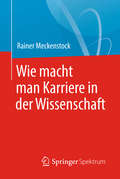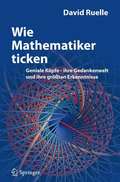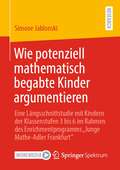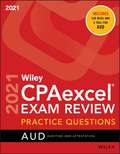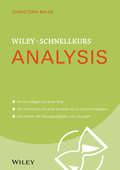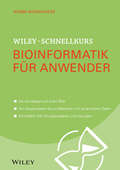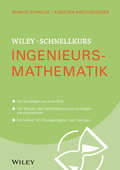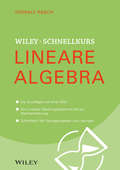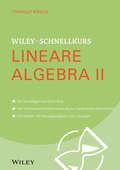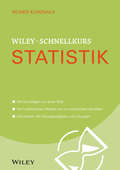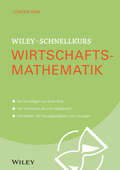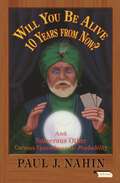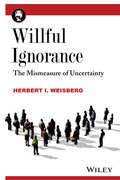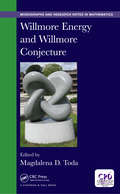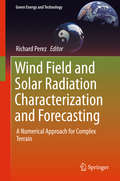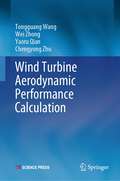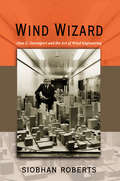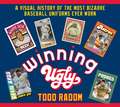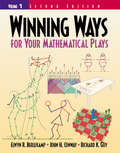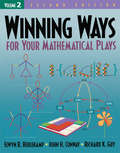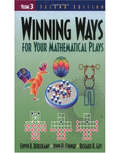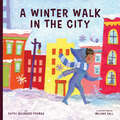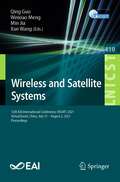- Table View
- List View
Wie macht man Karriere in der Wissenschaft
by Rainer Meckenstock Jan FröslerDieser Karriereratgeber liefert Transparenz im Dschungel des Wissenschaftssystems. Der erfahrene Wissenschaftler Rainer Meckenstock gibt konkrete Tipps für den eigenen Weg – vom Studium über die Doktoranden- und Postdoc-Zeit bis hin zur ersten Professur: Nach welchen Kriterien sollen sich angehende Forscher ihre Arbeitsgruppe aussuchen? Wie bauen sie ein Profil aus wissenschaftlicher und technischer Kompetenz auf? Welche Ziele sollten Jungforscher für die wissenschaftliche Arbeit im Auge behalten? Die Antworten werden mit Zeichnungen von Jan Frösler illustriert. Das Buch regt die Diskussion zwischen Nachwuchskräften und erfahrenen Wissenschaftlern oder Mentoren an und dient als Inspiration für ein Coaching. Es richtet sich an alle Wissenschaftler, um entweder die eigene Karriere oder die Ausbildung des Nachwuchses zu fördern. Ergänzend zeigen sieben Professorinnen und Professoren anhand ihrer Lebensläufe, wie vielfältig die Karrierewege in der Wissenschaft sein können, und geben ihre eigenen Erfolgsratschläge.
Wie Mathematiker ticken
by David RuelleDer renommierte mathematische Physiker David Ruelle schildert in dem Buch seine persönlichen Erfahrungen mit berühmten Mathematikern, deren Eigenarten und persönliche Tragödien - aber auch die erhabene Schönheit ihrer Entdeckungen. Jedes Kapitel stellt eine herausragende mathematische Idee und den visionären Verstand dahinter vor. Dabei gibt der Autor Einblick in die einzigartige Denkweise von Mathematikern und zeigt, weshalb er ihre Herangehensweise, um Fragen nach Sinn, Schönheit und Natur der Wirklichkeit zu diskutieren, für die beste hält.
Wie potenziell mathematisch begabte Kinder argumentieren: Eine Längsschnittstudie mit Kindern der Klassenstufen 3 bis 6 im Rahmen des Enrichmentprogramms „Junge Mathe-Adler Frankfurt“
by Simone JablonskiIn einer qualitativen Längsschnittstudie untersucht Simone Jablonski Veränderungen beim mündlichen Argumentieren von potenziell mathematisch begabten Kindern. Dazu entwickelt sie ein Analyseschema, das die Kategorien Struktur, Inhalt, Gültigkeit, Schlussweise und Eigenständigkeit berücksichtigt. Mithilfe aufgabenbasierter Interviews aus dem Bereich der Arithmetik werden 37 Kinder der Klassenstufen 3 bis 6 über anderthalb Jahre wiederholt befragt. Die Analyse der dabei entstandenen Argumentationsprodukte ergibt sechs verschiedene Argumentationstypen, die die Veränderungen beim Argumentieren einerseits und die Unterschiede zwischen den Kindern andererseits deutlich machen. Letztlich können auf Basis der gebildeten Typen Konsequenzen für die Förderung mathematisch begabter Kinder abgeleitet werden.
Wiley CPAexcel® Exam Review Practice Questions 2021 Auditing and Attestation
by Donald E. Tidrick Robert A. PrenticeThis Wiley CPAexcel® Exam Review PRACTICE QUESTIONS 2021 AUDITING AND ATTESTATION includes Multiple Choice Questions, Ethics, Professional Responsibilities, and General Principles, Assessing Risk and Developing a Planned Response and much more.
Wiley-Schnellkurs Analysis (Wiley Schnellkurs)
by Christoph MaasOb in Wirtschafts-, Natur-, oder Ingenieurswissenschaften, sobald Sie sich mit Mathematik beschäftigen müssen, kommen Sie an der Analysis nicht vorbei. Leider wird die ab einem gewissen Niveau recht abstrakt und ist auf Anhieb nicht immer leicht zu verstehen. Christoph Maas erklärt Ihnen in diesem Buch zügig, was Sie über Analysis wissen sollten: von Funktionen mit einer oder mehreren Variablen, über Ableitungen bis zu Integralen. Mit zahlreichen Beispielen und Übungsaufgaben mit Lösungen können Sie Ihr Wissen testen und festigen. So hilft Ihnen dieses Buch besonders, wenn es etwas mehr als die übliche Schulmathematik sein soll.
Wiley-Schnellkurs Bioinformatik für Anwender (Wiley Schnellkurs)
by Röbbe WünschiersDie digitale Datenverarbeitung wird auch für Lebenswissenschaftler immer wichtiger. Hier setzt dieser Schnellkurs an. Röbbe Wünschiers erklärt Ihnen, wie Sie mit Sequenz-, Struktur- und anderen Daten umgehen sollten. Er erläutert, wie Sie Linux als virtuelle Maschine installieren und wie Ihnen Linuxtools wie Sed oder die einfache Programmiersprache AWK bei der Datenanalyse helfen können. Außerdem führt er Sie knapp in weitere Bereiche ein, die Ihnen das digitale Leben erleichtern können: das Datenbanksystem MariaDB/MySQL, die Programmierumgebung R für statistisches Rechnen und Datenvisualisierung, die Textsatzsprache LaTeX und einiges mehr. Ausgearbeitete Beispiele aus den Lebenswissenschaften und Übungsaufgaben samt Lösungen helfen Ihnen Ihr Wissen zu festigen und zu überprüfen. Auf der Webseite datenmassen.de finden sich alle Daten und Abbildungen zum Download.
Wiley-Schnellkurs Ingenieursmathematik (Wiley Schnellkurs)
by Marco Schreck Karsten KirchgessnerMathematik ist ein zentraler Bestandteil in der Ausbildung von Ingenieuren und Technikern. Leider sind von der Schulzeit her oft nur rudimentäre Ansätze vorhanden. Genau für diese Leser haben Marco Schreck und Karsten Kirchgessner dieses Buch geschrieben. Sie geben Ihnen eine kurze Einführung in Differenzial- und Integralrechnung, komplexe Zahlen, Vektoren und Matrizen, analytische Geometrie und vieles mehr. Viele Übungsaufgaben mit Lösungen helfen Ihnen, Ihr Wissen zu festigen und zu prüfen. So hilft Ihnen das Buch bei Ihrem Start in die Ingenieursmathematik, oder wenn Sie Ihr Wissen mehr in der Breite als in der Tiefe wieder auffrischen müssen. Schnell lernen: Der Einstiegstest: So überprüfen Sie Ihr Wissen und verbessern es gezielt. Die Lerntipps: So profitieren Sie von der Lehrerfahrung der Autoren. Die Übungsaufgaben mit Lösungen: So überprüfen und festigen Sie Ihr Wissen.
Wiley-Schnellkurs Lineare Algebra (Wiley Schnellkurs)
by Thoralf RäschSie ist nicht beliebt und manchmal schwer zu verstehen: die Lineare Algebra. Aber keine Sorge: Thoralf Räsch hat ein kompaktes und verständliches Buch geschrieben, das Ihnen hilft, die Grundlagen der Linearen Algebra zu verstehen. Er erklärt Ihnen, was Sie über die algebraischen Grundlagen, Vektorräume, Lineare Gleichungssysteme und Matrizen wissen sollten. Auch die komplexen Zahlen kommen nicht zu kurz. Übungsaufgaben und Lösungen helfen Ihnen, Ihr Wissen zu festigen und zu überprüfen. So hilft Ihnen dieses Buch beim Grundverständnis der Linearen Algebra, wenn es einmal schnell gehen soll.
Wiley-Schnellkurs Lineare Algebra II (Wiley Schnellkurs)
by Thoralf RäschBei etwas komplizierteren Fragestellungen kommen Sie oft mit den Grundlagen der Linearen Algebra nicht weiter. Hier hilft Ihnen dieses Buch. Thoralf Räsch erklärt Ihnen zu Beginn ganz knapp die Grundlagen, geht dann aber schnell weiter zu Koordinatentransformation, Eigenwerten und Eigenvektoren. Er erläutert zudem Determinanten von Matrizen, euklidische Vektorräume, Definiertheit von Matrizen und vieles mehr. Mit Übungsaufgaben samt Lösungen können Sie Ihr Wissen testen und festigen.
Wiley-Schnellkurs Statistik (Wiley Schnellkurs)
by Reiner KurzhalsEs gibt nur wenige Studiengänge, in denen Sie an der Statistik vorbeikommen. Statistik gilt zudem als anspruchsvoll und sehr lernintensiv, aber Sie können auch zu sehr spannenden Ergebnissen kommen. Reiner Kurzhals erklärt Ihnen so knapp und verständlich wie möglich, was Sie über Statistik wissen müssen. Er erläutert neben den Grundbegriffen die wichtigsten Punkte der beschreibenden und der schließenden Statistik. Viele Beispiele helfen Ihnen dabei, sich die abstrakten Formeln und Begriffe besser vorstellen zu können. Mit den zahlreichen Übungsaufgaben mit Lösungen können sie Ihr Wissen festigen und prüfen.
Wiley-Schnellkurs Wirtschaftsmathematik (Wiley Schnellkurs)
by Jürgen FaikWirtschaftsmathematik: Das hört sich erst einmal nicht spannend an, aber Mathematik hilft Ihnen, viele wichtige Themen zu verstehen und Zusammenhänge zu ermitteln. Außerdem muss man hier meist eine Klausur schreiben. Jürgen Faik gibt Ihnen eine schnelle Einführung und einen verständlichen Überblick über die Wirtschaftsmathematik. Er beginnt bei den Grundlagen wie Rechenregeln, Gleichungen, Folgen, Reihen und Funktionen. Dann erklärt er Ihnen, was Sie zu Differential- und Integralrechnung wissen müssen. Er erläutert das Wichtigste zur Linearen Algebra und zuletzt hilft er Ihnen bei Ihren ersten Schritten in der Finanzmathematik. Mit vielen Übungsaufgaben samt Lösungen können Sie sich selbst testen und Ihr Wissen festigen.
Will You Be Alive 10 Years from Now?: And Numerous Other Curious Questions in Probability
by Paul J. NahinA collection of stimulating probability puzzles from bestselling math writer Paul NahinWhat are the chances of a game-show contestant finding a chicken in a box? Is the Hanukkah dreidel a fair game? Will you be alive ten years from now? These are just some of the one-of-a-kind probability puzzles that acclaimed popular math writer Paul Nahin offers in this lively and informative book.Nahin brings probability to life with colorful and amusing historical anecdotes as well as an electrifying approach to solving puzzles that illustrates many of the techniques that mathematicians and scientists use to grapple with probability. He looks at classic puzzles from the past--from Galileo's dice-tossing problem to a disarming dice puzzle that would have astonished even Newton—and also includes a dozen challenge problems for you to tackle yourself, with complete solutions provided in the back of the book.Nahin then presents twenty-five unusual probability puzzlers that you aren't likely to find anywhere else, and which range in difficulty from ones that are easy but clever to others that are technically intricate. Each problem is accompanied by an entertaining discussion of its background and solution, and is backed up by theory and computer simulations whenever possible in order to show how theory and computer experimentation can often work together on probability questions. All the MATLAB® Monte Carlo simulation codes needed to solve the problems computationally are included in the book. With his characteristic wit, audacity, and insight, Nahin demonstrates why seemingly simple probability problems can stump even the experts.
Willful Ignorance
by Herbert I. WeisbergAn original account of willful ignorance and how this principle relates to modern probability and statistical methods Through a series of colorful stories about great thinkers and the problems they chose to solve, the author traces the historical evolution of probability and explains how statistical methods have helped to propel scientific research. However, the past success of statistics has depended on vast, deliberate simplifications amounting to willful ignorance, and this very success now threatens future advances in medicine, the social sciences, and other fields. Limitations of existing methods result in frequent reversals of scientific findings and recommendations, to the consternation of both scientists and the lay public.Willful Ignorance: The Mismeasure of Uncertainty exposes the fallacy of regarding probability as the full measure of our uncertainty. The book explains how statistical methodology, though enormously productive and influential over the past century, is approaching a crisis. The deep and troubling divide between qualitative and quantitative modes of research, and between research and practice, are reflections of this underlying problem. The author outlines a path toward the re-engineering of data analysis to help close these gaps and accelerate scientific discovery. Willful Ignorance: The Mismeasure of Uncertainty presents essential information and novel ideas that should be of interest to anyone concerned about the future of scientific research. The book is especially pertinent for professionals in statistics and related fields, including practicing and research clinicians, biomedical and social science researchers, business leaders, and policy-makers.
Willmore Energy and Willmore Conjecture (Chapman & Hall/CRC Monographs and Research Notes in Mathematics)
by Magdalena D. TodaThis book is the first monograph dedicated entirely to Willmore energy and Willmore surfaces as contemporary topics in differential geometry. While it focuses on Willmore energy and related conjectures, it also sits at the intersection between integrable systems, harmonic maps, Lie groups, calculus of variations, geometric analysis and applied differential geometry. Rather than reproducing published results, it presents new directions, developments and open problems. It addresses questions like: What is new in Willmore theory? Are there any new Willmore conjectures and open problems? What are the contemporary applications of Willmore surfaces? As well as mathematicians and physicists, this book is a useful tool for postdoctoral researchers and advanced graduate students working in this area.
Wind Field and Solar Radiation Characterization and Forecasting: A Numerical Approach For Complex Terrain (Green Energy And Technology)
by Richard PerezIn addition to describing core concepts and principles, this book reveals professional methodologies and tools used by national agencies and private corporations to predict sites’ potential for wind and solar power generation. Each chapter focuses on a different issue, showing readers the corresponding methodology, as well as examples of how to apply the techniques described. These techniques are explained with step-by-step guides that demonstrate how environmental variables in complex terrains can be characterized and forecasted.The authors present an adaptive finite element mass-consistent model, which computes a diagnostic wind field in the three-dimensional area of interest using observed wind data from measurement stations – data which is then interpolated using a physical model of the wind field in the boundary layer. An ensemble method is presented based on the perturbation of the numerical weather prediction models’ results. The book goes on to explain solar radiation characterization and forecasting. Solar radiation and electrical power generation temporal and spatial variability are discussed and modelled. Different statistical methods are presented in order to improve solar radiation forecasting using ground measurement, numerical weather predictions (NWPs) and satellite-derived data. This book is focused on both probabilistic and point forecast explaining different models and methodologies to improve the forecasting. The results obtained from various simulations around the world are presented in tables. Finally, the book explains a possible methodology to develop a Solar Map taking into account solar radiation, terrain surface conditions and cast shadows.As such, the book provides an overview of the concepts, principles and practices involved in the treatment of environmental variables related to solar radiation or wind fields, especially when complex terrains are involved, offering useful resources for students and researchers alike. It also equips professionals with the methodologies and tools needed to construct environmental variable maps and conduct forecasting for solar radiation and wind fields.
Wind Resistant Design of Bridges in Japan
by Hiroshi Tanaka Kichiro Kimura Yozo FujinoFor long-span bridges, wind action is a dominant factor in their safety and serviceability. A large number of long-span bridges have been built in Japan over the past 30 years, and tremendous amounts of research and technical development have been accomplished in wind-resistant design. This book is a compilation of the results of active research and development. Wind-resistant design standards generated in Japan are described in the first few chapters. Then comes information such as design wind speed, structural damping, wind tunnel tests, and analyses, which provide the basis of the design standards. Wind-induced vibrations and their control of girders, towers, cables, and other features are explained with examples of field measurements. Comprehensive listings of Japanese experience in vibration control are also presented. Because achieving particularly dynamic safety against wind is still not an easy task, these data and information will be valuable assets for the wind-engineering and bridge-engineering communities.
Wind Turbine Aerodynamic Performance Calculation
by Tongguang Wang Wei Zhong Yaoru Qian Chengyong ZhuThis book deals with horizontal-axis wind turbine aerodynamic performance prediction methods. It focuses on the traditional and newly-developed methods for the wind turbine aerodynamic performance calculation. The fundamental theories of fluid mechanics essential for understanding the other parts of this book are firstly introduced in Part I, followed by the blade element momentum theory in Part II, with special attentions to a systematic review of various correction models. Part III is mainly about the prescribed and free vortex wake methods, while the state-of-art computational fluid dynamics (CFD) methods are detailed in Part IV.Part III thoroughly describes the prescribed and free vortex wake methods which are still of great importance towards realistic investigation of wind turbine performance. Despite the highly computational cost, the CFD methods in Part IV have received increasing interest from the academic community since they provide more detailed information about the flow field around the wind turbine. This has shed a light in combination with the correction models introduced in Part II on more advanced research for wind turbine.This book is intended for researchers and students interested in aerodynamics of wind turbine and is particularly suitable for practicing engineers in wind energy. Readers can gain a comprehensive understanding in both classical and up-to-date methods for the study of wind turbine aerodynamics. The authors hope that this book can promote the research and development of wind turbines.
Wind Wizard
by Siobhan RobertsWith Wind Wizard, Siobhan Roberts brings us the story of Alan Davenport (1932-2009), the father of modern wind engineering, who investigated how wind navigates the obstacle course of the earth's natural and built environments--and how, when not properly heeded, wind causes buildings and bridges to teeter unduly, sway with abandon, and even collapse. In 1964, Davenport received a confidential telephone call from two engineers requesting tests on a pair of towers that promised to be the tallest in the world. His resulting wind studies on New York's World Trade Center advanced the art and science of wind engineering with one pioneering innovation after another. Establishing the first dedicated "boundary layer" wind tunnel laboratory for civil engineering structures, Davenport enabled the study of the atmospheric region from the earth's surface to three thousand feet, where the air churns with turbulent eddies, the average wind speed increasing with height. The boundary layer wind tunnel mimics these windy marbled striations in order to test models of buildings and bridges that inevitably face the wind when built. Over the years, Davenport's revolutionary lab investigated and improved the wind-worthiness of the world's greatest structures, including the Sears Tower, the John Hancock Tower, Shanghai's World Financial Center, the CN Tower, the iconic Golden Gate Bridge, the Bronx-Whitestone Bridge, the Sunshine Skyway, and the proposed crossing for the Strait of Messina, linking Sicily with mainland Italy. Chronicling Davenport's innovations by analyzing select projects, this popular-science book gives an illuminating behind-the-scenes view into the practice of wind engineering, and insight into Davenport's steadfast belief that there is neither a structure too tall nor too long, as long as it is supported by sound wind science.
Windows to Algebra and Geometry: An Integrated Approach
by Ron LarsonAs you study this book you will be able to understand the value and purpose of what you are learning. That's why the book begins each lesson explaining what you should learn and why you should learn it.
Winning Ugly: A Visual History of the Most Bizarre Baseball Uniforms Ever Worn
by Todd RadomBaseball, our national pastime. Every fan has memories of their team’s incredible victories and anguishing defeats. We remember the home runs, the walk-off wins, and the moments that will last a lifetime. We also remember those things which we wish we could forget: the errors, the mental mistakes . . . and the ugly uniforms.In an ode to those eyesores, Todd Radom has collected and chronicled some of the swing-and-misses we’ve ever seen on the baseball diamond. Remember when the Chicago White Sox thought wearing shorts in 1977 was a good idea? How about when the Baltimore Orioles wore their all-orange jerseys in 1971? Do you remember the 1999 “Turn Ahead the Clock” campaign? Or the most recent all-camo jerseys of San Diego Padres?Yes, there is much to talk about when it comes to the odd uniform decisions teams have made over the years. But just like there’s love out there for French bulldogs or Christmas sweaters, ugly uniforms hold a warm place in the heart of all baseball fans.Sure they didn’t affect wins and losses (unless you mention Chris Sale), but a fan’s love and ire goes well beyond the current standings. So whether your team appears in Ugly Baseball Uniforms or not, fans of the sport will enjoy reliving the moments most teams would like to forget.
Winning Ways for Your Mathematical Plays: Volume 1
by Elwyn R. Berlekamp John H. Conway Richard K. GuyThis classic on games and how to play them intelligently is being re-issued in a new, four volume edition. This book has laid the foundation to a mathematical approach to playing games. The wise authors wield witty words, which wangle wonderfully winning ways. In Volume 1, the authors do the Spade Work, presenting theories and techniques to "dissect" games of varied structures and formats in order to develop winning strategies.
Winning Ways for Your Mathematical Plays, Volume 2: Volume 1 (AK Peters/CRC Recreational Mathematics Series)
by John H. Conway Elwyn R. Berlekamp Richard K. GuyIn the quarter of a century since three mathematicians and game theorists collaborated to create Winning Ways for Your Mathematical Plays, the book has become the definitive work on the subject of mathematical games. Now carefully revised and broken down into four volumes to accommodate new developments, the Second Edition retains the original's wealth of wit and wisdom. The authors' insightful strategies, blended with their witty and irreverent style, make reading a profitable pleasure. In Volume 2, the authors have a Change of Heart, bending the rules established in Volume 1 to apply them to games such as Cut-cake and Loopy Hackenbush. From the Table of Contents: - If You Can't Beat 'Em, Join 'Em! - Hot Bottles Followed by Cold Wars - Games Infinite and Indefinite - Games Eternal--Games Entailed - Survival in the Lost World
Winning Ways for Your Mathematical Plays, Volume 3: Volume 1 (AK Peters/CRC Recreational Mathematics Series)
by John H. Conway Elwyn R. Berlekamp Richard K. GuyIn the quarter of a century since three mathematicians and game theorists collaborated to create Winning Ways for Your Mathematical Plays, the book has become the definitive work on the subject of mathematical games. Now carefully revised and broken down into four volumes to accommodate new developments, the Second Edition retains the original's wealth of wit and wisdom. The authors' insightful strategies, blended with their witty and irreverent style, make reading a profitable pleasure. In Volume 3, the authors examine Games played in Clubs, giving case studies for coin and paper-and-pencil games, such as Dots-and-Boxes and Nimstring. From the Table of Contents: - Turn and Turn About - Chips and Strips - Dots-and-Boxes - Spots and Sprouts - The Emperor and His Money - The King and the Consumer - Fox and Geese; Hare and Hounds - Lines and Squares
Winter Walk in the City (In The City Ser.)
by Cathy Goldberg FishmanFollow this adventure through the city in the winter, and peek into the windows to explore multicultural winter holidays.
Wireless and Satellite Systems: 12th EAI International Conference, WiSATS 2021, Virtual Event, China, July 31 – August 2, 2021, Proceedings (Lecture Notes of the Institute for Computer Sciences, Social Informatics and Telecommunications Engineering #410)
by Qing Guo Weixiao Meng Min Jia Xue WangThis book constitutes the refereed post-conference proceedings of the 12th International Conference on Wireless and Satellite Services, WiSATS 2021, held in Nanjing, China, in September 2020. Due to COVID-19 pandemic the conference was held virtually. The 79 full papers were carefully reviewed and selected from 140 submissions. The conference’s central theme is the means of using the wireless and satellite services directly to the user for personal communications, multimedia and location identification. The services enabled by WiSATS not only cover the requirements of an ordinary citizen but also provide personal and public services for global coverage communications as the applications of internet of things.
